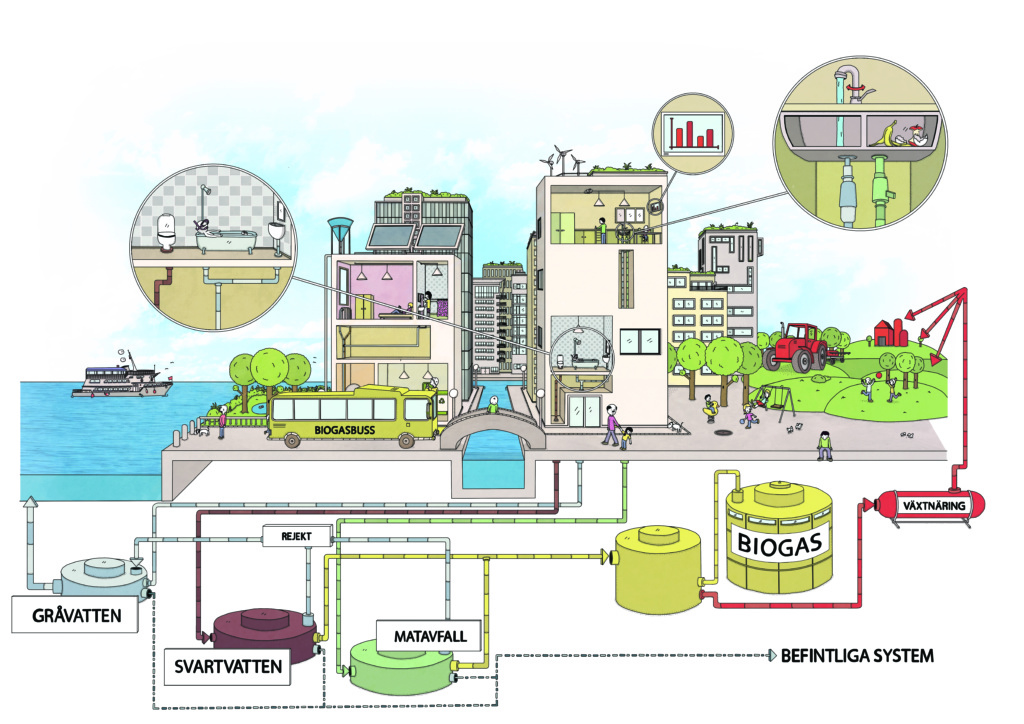New waste and wastewater management system in Oceanhamnen
As a first step in the H+ environmental profile, Helsingborg is planning to implement a new and unique waste and wastewater management system, with many advantages. When the building of Oceanhamnen starts, the new and sustainable system will be in place for the construction companies to connect the new buildings to.
“The construction companies who will be involved in the first phase of building Oceanhamnen will be pioneers in connecting to the new waste and wastewater management system. The ambition is that the system will be so smart and efficient that it can become a successful international export,” says Marinette Hagman, responsible for research and development at NSVA (Nordvästra Skånes Vatten och Avlopp).
Based on several pilot studies and experiences from international visits along with current preconditions, the city has decided to implement the new system. There are several advantages both for the residents and from a sustainability perspective.
Studies show that this type of system reduces emissions of greenhouse gasses by more than 50 percent compared to the system used today. Resources in the different types of waste and wastewater can also be utilized in a more efficient manner. The long-term ambition is also for this system to become cheaper than the current one.
“We have been sorting food waste for ten years and it has become an obvious part of everyday life for Helsingborg’s citizens. Because Helsingborg was among the first in the country to implement this type of sorting, it’s natural that we now take the next step towards developing this waste collection. While we make it even easier for the user, we’re also securing a cycle of plant nutrients and biogas production,” says Angelika Blom, sewage strategist at NSR.

Comfortable, easy and convenient. The overarching goal is to collect and use the waste, as a raw material, to produce biogas and plant nutrients in a safe way. In other words, the system will contribute to Helsingborg City’s environmental targets for the H+ area but also to the climate- and environmental work that is being done at a national level.
To collect food waste we will install kitchen grinders in the kitchen and vacuum toilets to collect toilet water. Bath, shower and wash water will be sorted in a separate pipe.
The advantages of waste disposal units:
- Comfortable, easy, and convenient for those living in the area.
- Cleaner and more pleasant sorting rooms for collecting and sorting other kinds of waste.
- Agriculture gains access to a cleaner fertilizer without trash that doesn’t belong in food waste.
- Larger amounts of food waste gets collected and turned into biogas. That what is left over becomes fertilizer for arable land.
- Reduced need for heavy transportation in the area.
- Reduced losses in the management chain and thereby increased production of biogas and fertilizer.
The advantages of vacuum toilets:
- A more energy-efficient management at the treatment plant thanks to reduced water quantities. With new treatment techniques, greenhouse gas emissions are reduced.
- Increased production of biogas as anaerobic digestion can take place directly without prior handling at the treatment plant.
- Reduced water consumption for the residents.
- A cleaner raw material, that is to say sludge, compared to current sewage water and sewage sludge that gets mixed together with all other sewage water from the rest of the community. This creates the necessary preconditions for increased circulation of nutrients back into the agricultural sector, which in turn contributes to Sweden’s national environmental targets.
- Good experiences of the vacuum system in households can be found, primarily in Germany and the Netherlands.
The advantages of collecting the greywater separately:
- By sorting bath, shower, and wash water in a separate pipe we can utilize the resources in the toilet water more efficiently.
- The heat in the warmer sewage stream is easier to reuse through heat exchange, which can be done directly in the building or at the treatment plant.
